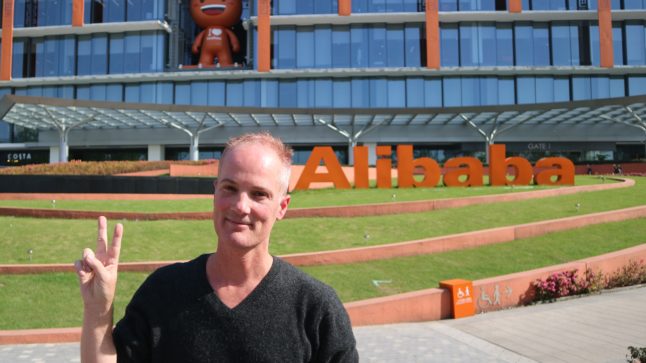In Part 1, I summarized Alibaba’s new strategy of refocusing on the core businesses (i.e., ecommerce and cloud). And on reigniting ecommerce in particular.
But everything I mentioned was about platform business models. In fact, virtually every business Alibaba has built in the past 25 years has been a platform business model. That is what they do.
However, new CEO Eddie Wu has been talking about the future of the company being platforms PLUS AI Services.
If true, that is an important shift. And is what you would hope to hear from a CEO who is a technologist.
I always refer to digital platforms (marketplaces, audience-builders, search engines) as the super-predators of the business world. They have been the ultimate predator for 20 years. Think the dinosaur running around the island in Jurassic Park. Think the lion on the savannah.
AI service businesses may be emerging as the new super predator. They may be real competitors to platforms. Think a tiger vs. a lion.
- Google Search (a powerful platform) has just gotten its first major competitor in ChatGPT (an AI service business).
- Uber (a marketplace platform) is going to be disrupted by robotaxis (an AI service business).
We’ll see. But I’m glad to hear Alibaba shifting to both platforms and AI services.
In fact, AI Services are one of three new digital business models I am watching for. That all look particularly powerful. I call this first one AI Service Pipelines. It’s a linear business model, but with more powerful characteristics. This is how I view it, compared to a traditional pipeline business model.
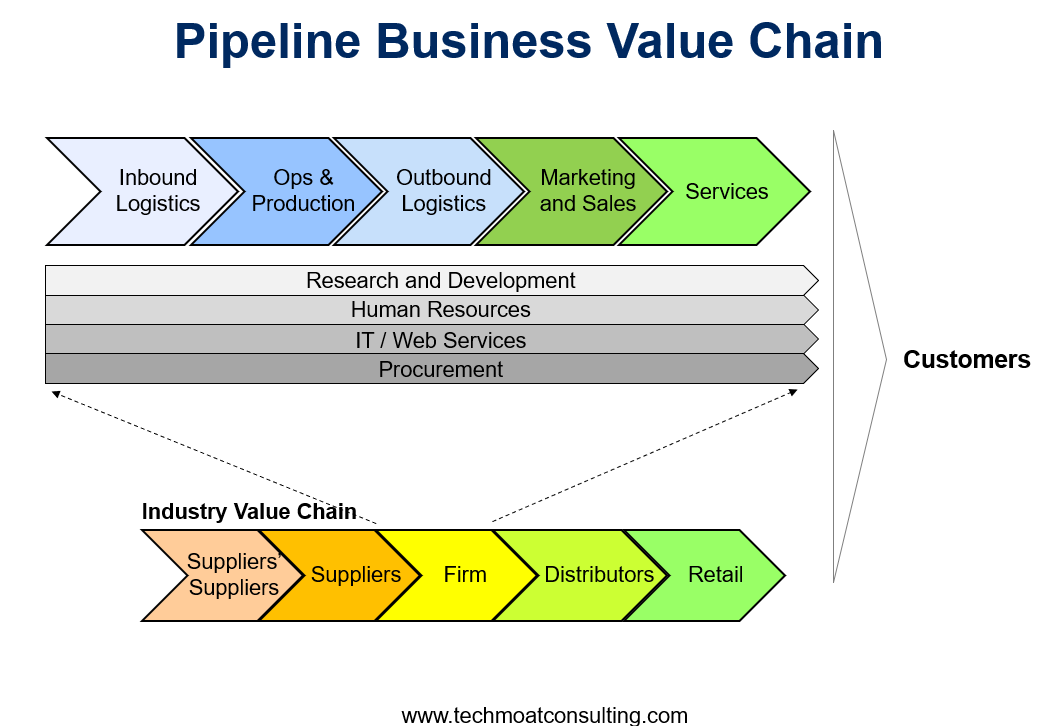
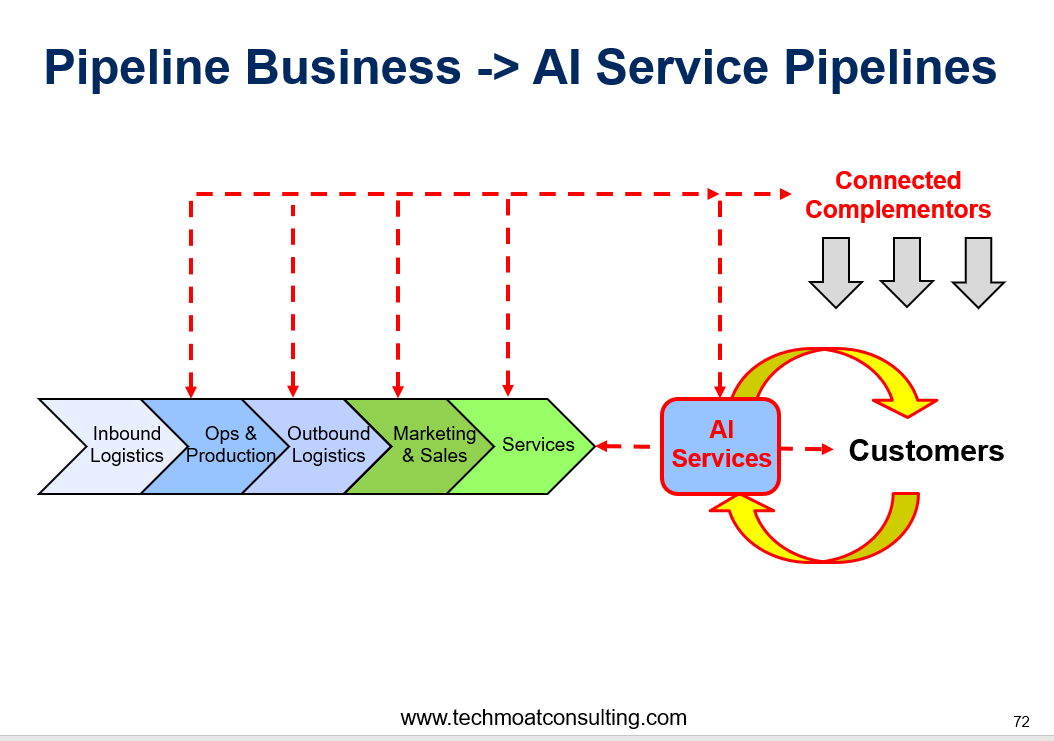
Basically, generative AI is creating new types of pipeline businesses with different characteristics than pipelines for goods, services, and digital goods.
These “AI Service Pipelines” have two important characteristics. They are connected. And they are intelligent.
Take Robotaxis as an example:
- Robotaxis are an AI-powered service that has increasing intelligence with customers and usage. We talked about this in “Intelligence Flywheels”.
- Robotaxis are connected to each other robotaxis. They can act as a connected fleet. They are also connected to complementary services and devices.
In Part 3, I’ll lay out the other new AI business models I am looking at.
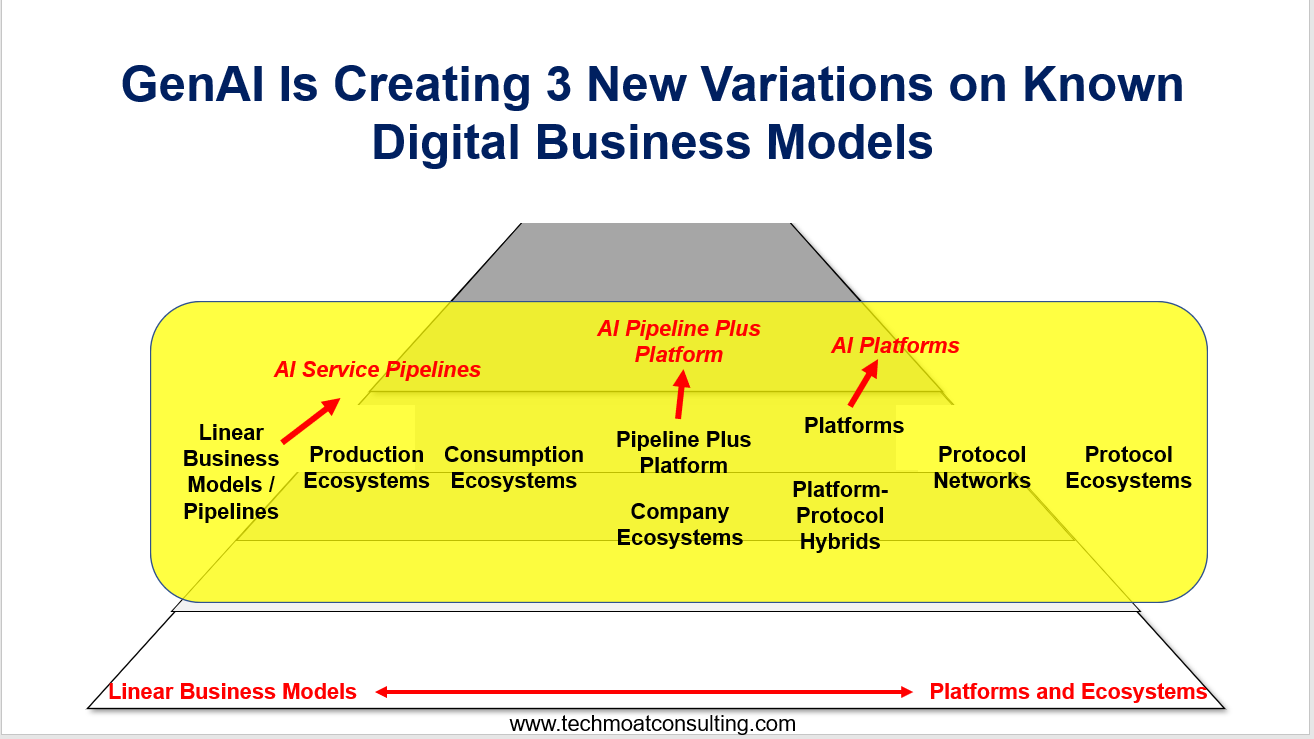
Ok. Let’s talk about what Alibaba is doing in Generative AI right now.
Recall GenAI Strategy 1.0
I recently described a simple strategy for generative AI, which I called GenAI Strategy 1.0. This is what most companies are doing right now. They are basically putting GenAI into products and into their internal operations. Which we definitely see at Alibaba right now.
Recall, my standard approach to digital strategy (which I outlined here) is to look at how technology is changing three related strategy goals.
- Getting Customers and Growth
- Improving Operations
- Building Moats
Here’s my standard digital strategy graphic.
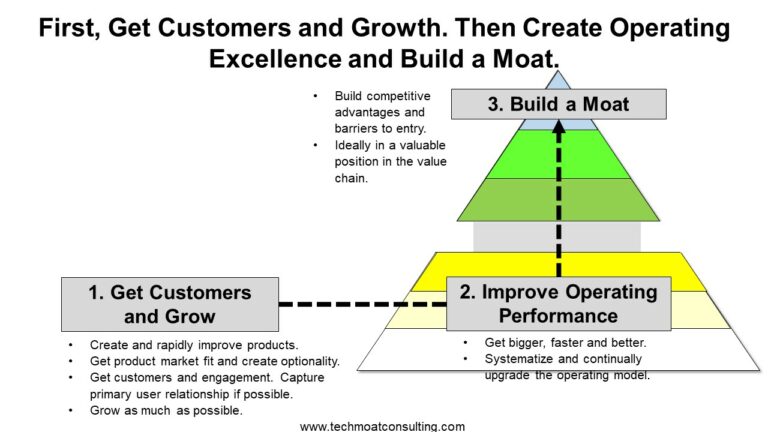
And I did a simpler version of this, where each goal is represented by a famous person.
- Steve Jobs is a good symbol for getting customers and growth. It’s a lot about product development.
- Elon Musk is a good symbol for operating and innovating like a maniac.
- Warren Buffet is a good symbol for building a moat. That’s all he does.

From this, you can look at the impact of generative AI on each goal.
And this gest you a starter strategy for generative AI, which I called GenAI Strategy 1.0. Basically, it’s about doing lots of experiments with GenAI in products and internal operations. I discussed this in a recent podcast.
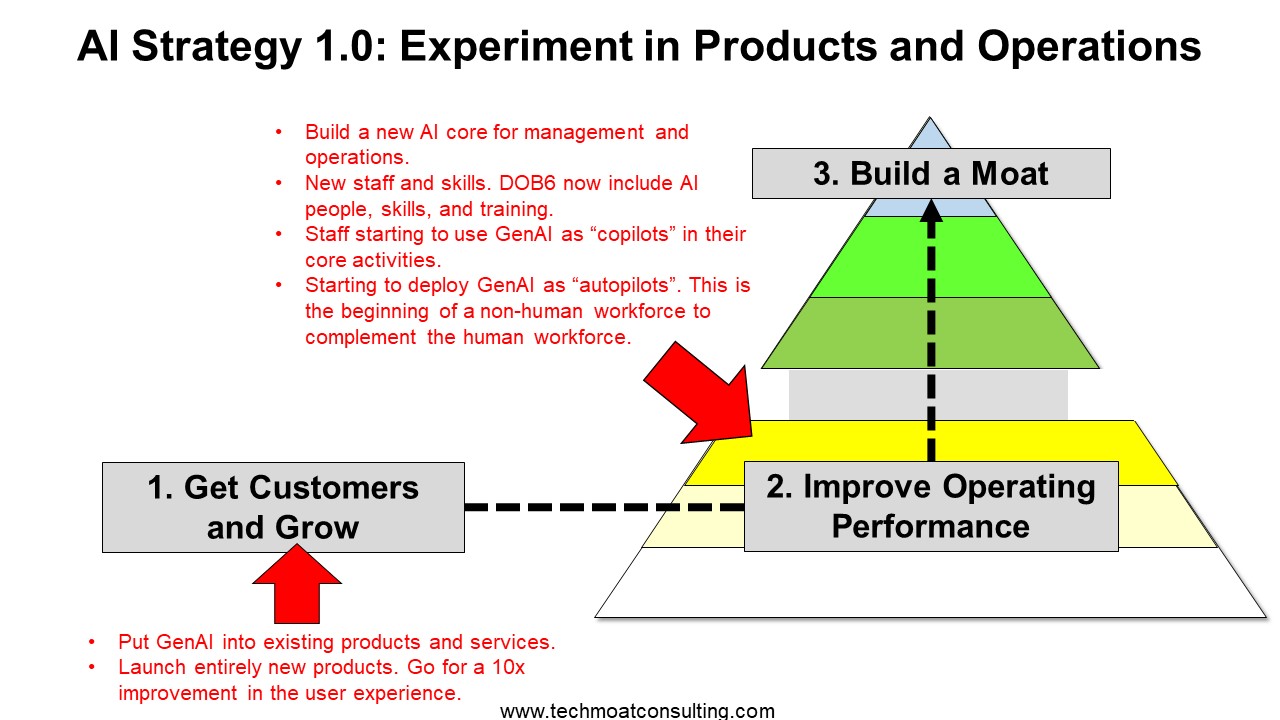
For most companies, Goal 2 is mostly about doing lots of internal training and operations building right now.

And when we look at Alibaba’s GenAI strategy right now, we basically see this same strategy.
Alibaba 1.0 Has Been About Putting GenAI into its Core Ecommerce Products
We have seen lots of announcements about Alibaba putting GenAI into its tools for merchants on Tmall and Taobao.
Keep in mind, Taobao and Tmall are marketplace business models. So, putting GenAI into products means putting it into the “products” as used both by customers and by merchants and brands on their marketplaces.
We can see them doing AI initiatives for both of these user groups. But most of the focus appears to be on new tools for merchants.
- Alibaba has a new AI Chatbot called Dianxiaomi. This is something that merchants can use to reach and interact with their customers. It is expected to be available to all merchants in June 2024. Note: Lazada has already been rolling out chatbots for merchants, via partnership with Microsoft(?).
- Alibaba has new content creation tools for merchants and Brands. Not a big surprise as generative AI is really good at generative content. This should enable merchants and brands to do more and better marketing and communication with customers on the platforms. It should enable increasingly personalized marketing and communication, which is a big focus. Joe Tsai was talking about this recently. Saying there is too much content in the world. So personalizing content is the key.
In recent earnings comments, Alibaba specifically mentioned their AI Tools for merchants. Saying “more and more SME merchants are starting to leverage AI to enhance their operating efficiency. 17,000 SME merchants have subscribed to the AI business helper launched on Alibaba.com and millions of products have now been launched with AI. Searches for AI-optimized products have increased by 37%.”
The goal with these new GenAI-infused products is:
- To help merchants improve their services and attract more customers. Increasing merchants’ customers and increasing customer satisfaction are usually the key ROIs. Alibaba recently said that that merchants on Taobao are achieving “one of the highest ROIs for their marketing investments compared to any other platform available today”.
- To level the playing field with large merchants and brands. For twenty years, Alibaba has been talking about how it builds tools that give SMEs the same capabilities as large merchants and brands. It gave them global distribution, great digital tools, secure payment, etc. So, it was expected that they would do the same with new GenAI tools.
Keep in mind, Alibaba has been making big moves recently in its marketing services for merchants. In their latest earnings announcement, they talked a lot about “monetization ad product”, saying they “will continue to launch planned monetization products and gradually introduce new monetization mechanisms in the second half of the year.”
In particular, they have talked about their omni-platform marketing solution, known as “Quanzhantui,”, which aims to make advertising easier for SMEs. They say, “we are enhancing the service and improving ROI by adjusting algorithms, training models, conducting tests, and utilizing data from those tests.”
Basically, they are going to add these GenAI and advertising tools to their current suite of merchant services. They like to offer services for every line of the income statement of a typical merchant.

Alibaba 1.0 Has Also Been About Putting GenAI into Cloud Services
No big surprise.
Alibaba has been aggressively putting GenAI capabilities into their cloud services. This is becoming one of their major service offerings.
Zhou Jingren, Chief Technology Officer for Alibaba Cloud, has been talking about this and their big GenAI investments. There’s a lot of focus on LLMs, custom apps and new solutions. He has been talking about their new serverless solutions. And they have been making frequent comments about dropping costs by half. Making these services much cheaper seems to be a big KPI.
Alibaba has recently made comments saying it has three objectives for research and development around AI and large models:
- To develop their own foundational models for AI and progress towards AGI.
- To internally integrate their Cloud offerings with their large language model within Alibaba. They say “this integration allows us to provide our customers with well-integrated software and hardware solutions. By combining our Cloud capabilities with our AI capabilities, we enable our customers to benefit from highly effective and cost-efficient AI functionality.”
- To leverage the “development of Tongyi to support other businesses within the Alibaba Group in enhancing their own applications for their respective industries.”
This is a whole big topic, which I won’t repeat here. I wrote about their AI Cloud strategy here.
***
That’s a pretty good summary of Alibaba’s GenAI Strategy 1.0. Pretty standard.
In Part 3, I’ll get into the bigger and more long-term moves I think Alibaba is making. I call that Alibaba’s new “AI Platforms”. I think it’s pretty cool stuff. 😊
Cheers, Jeff
———-
Related articles:
- A Breakdown of the Verisign Business Model (2 of 2) (Tech Strategy – Daily Article)
- 3 Factors Will Determine the Future of Verisign Inc. (Tech Strategy – Podcast 191)
- A Strategy Breakdown of Arm Holdings (1 of 3) (Tech Strategy – Daily Article)
From the Concept Library, concepts for this article are:
- Ecommerce
- Cloud Services
- Generative AI
From the Company Library, companies for this article are:
- Alibaba
- Tmall and Taobao
- Alibaba Cloud
————
I am a consultant and keynote speaker on how to increase digital growth and strengthen digital AI moats.
I am the founder of TechMoat Consulting, a consulting firm specialized in how to increase digital growth and strengthen digital AI moats. Get in touch here.
I write about digital growth and digital AI strategy. With 3 best selling books and +2.9M followers on LinkedIn. You can read my writing at the free email below.
Or read my Moats and Marathons book series, a framework for building and measuring competitive advantages in digital businesses.
This content (articles, podcasts, website info) is not investment, legal or tax advice. The information and opinions from me and any guests may be incorrect. The numbers and information may be wrong. The views expressed may no longer be relevant or accurate. This is not investment advice. Investing is risky. Do your own research.
